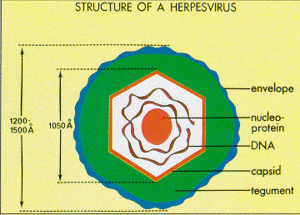Roseolovirus
Classification
Viruses; dsDNA viruses, no RNA stage; Herpesvirales; Herpesviridae; Betaherpesvirinae; Roseolovirus [Others may be used. Use NCBI link to find]
Roseolovirus 6A, 6B, 7
Description and Significance
Roseolovirus is a group 1 virus according to the Baltimore classification system. This distinction indicates double stranded viral DNA. Other viruses in Group 1 include the family Poxviridae which includes the smallpox virus, and other subfamilies within the Herpesviridae family like varicella-zoster virus that causes chickenpox. [1]
Roseoloviruses infect human hosts and can integrate into the host's genome where it enters a latent stage. Certain drugs have been shown to reactivate the virus. However, reactivations rarely occur in immunocompetent hosts. [4]
Structure, Metabolism, and Life Cycle
Interesting features of its structure; how it gains energy (how it replicates, if virus); what important molecules it produces (if any), does it have an interesting life cycle?
Pathogenesis
Roseoloviruse HHV-6B can cause roseola infantum (aka Exanthema Subitum) in children under the age of three. Symptoms include a high-grade fever and a rash originating on the trunk. [3] The severity of the fever can induce seizures. Treatment is often limited to fever-reducing medications like acetaminophen and ibuprofen as the rash and fever resolve in a few days. Sedatives may be administered to patients who are susceptible to seizures. [5]
Because herpesviruses can integrate into the host's genome, reactivations can occur in immunocompromised hosts. These symptoms include rash, fever, seizures, encephalopathy, limbic encephalitis, amnesia, cognitive dysfunction, lymphadenopathy, colitis and hepatitis. [4]
Other associations between HHV-6A and HHV-6B and several autoimmune disorders have been investigated. These studies produced results with varying degrees of evidentiary support. [2]
Although there is no evidence of HHV-6A playing a role in the pathogenesis of Multiple Sclerosis, active HHV-6A infection was found in the blood and cerebrospinal fluid of patients with relapsing MS. Other indications of HHV-6A were also discovered in MS patients. [2]
References
[1] EXAMPLE ONLY. REPLACE WITH YOUR REFERENCES. Takai, K., Sugai, A., Itoh, T., and Horikoshi, K. 2000. "Palaeococcus ferrophilus gen. nov., sp. nov., a barophilic, hyperthermophilic archaeon from a deep-sea hydrothermal vent chimney". International Journal of Systematic and Evolutionary Microbiology. 50: 489-500. http://ijs.sgmjournals.org/cgi/reprint/50/2/489
[1] Slonczewski JL, Foster JW. "Microbiology, An Evolving Science." 2nd Ed. New York: W.W. Norton and Company, Inc., 2011.
[2]
[3] Exanthem Subitum. Reference.MD. 2012. http://www.reference.md/files/D005/mD005077.html
[4] Pellett PE, Ablashi DV, Ambros PF, et al. Chromosomally integrated human herpesvirus 6: questions and answers. Rev. Med. Virol. 2012; 22: 144-155. http://onlinelibrary.wiley.com.ezp1.lib.umn.edu/doi/10.1002/rmv.715/pdf
[5] Kohl, Steve. "Human Herpesvirus 6." in Nelson Textbook of Pediatrics, edited by Richard E. Behrman. Philadelphia: W.B. Saunders Co., 1996. http://medical-dictionary.thefreedictionary.com/Roseolovirus+infections
Author
Page authored by Morgan Schwoch, student of Mandy Brosnahan, Instructor at the University of Minnesota-Twin Cities, MICB 3301/3303: Biology of Microorganisms.

